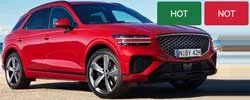I beg to differ but offset has absolutely no bearing on whether or not a rim fits over a brake caliper. As long as the rim is of sufficient diameter to clear the outside of the caliper offset does not come into play. Offset is merely the position of the rim in relationship to the centerline of the mounting surface. The clearance issues with the Genesis was that the inside face of the wheel was hitting the face of the caliper and no offset came into play it was solely the contour of the inside of the rim. A spacer will change the offset relative to mounting position on the car but it does not change the actual offset of the wheel it only pushes the wheel farther from the caliper and that is different.
You are correct, unless you have the inside mounting face of the
rim milled down professionally, you cannot change the offset of a
rim, but you can change the offset of the mount and overall setup w/ spacers once the lugs are attached and
wheel/tire is on the car.
In this discussion we have have forgot to mention one particular factor that goes along with
rim offset when mentioning brake calipers and wheels. the axle offset measurement that comes from the factory.
'it only pushes the wheel farther from the caliper and that is different.' -- what do you call that measurement then? the negative impact on offset relative to the actual
wheel offset?
http://www.stoptech.com/technical-support/bbk-wheel-fitment-templates
'Brakes exist in the space between the wheels and the hub on a vehicle. On the inboard side, there are suspension pieces. The diameter of the brakes can't exceed the inner diameter of the wheel used, and the inside spokes of the wheels limit how wide the brake calipers can be. In this confined space StopTech produces brakes are larger than stock brakes to provide more performance.
Space for the calipers varies by wheel design. Two wheels with the same offset, same diameter, and same width will yield two different fitments. One that does fit over the brakes, and one that does not. For that reason it is crucial to use the wheel fitment templates to check whether a wheel will fit over the brakes for your specific application.
If there is interference, different wheels or a wheel spacer will be necessary. Use of a wheel spacer is at the discretion of the vehicle owner. Typically a properly made spacer of 2-3mm will not adversely effect the vehicle. Issues that must be addressed before utilizing a wheel spacer include, but are not limited to, fender clearance, proper wheel bolt or stud length, effect on vehicle handling, and centering of the wheel. Wheel fitment and the use of wheel spacers with our big brake upgrades is the responsibility of the customer.
However, I will also go on to rant against
wheel spacers and the ability to pay to play, attaining the offsets one desires while clearing brake caliper assemblies.
The proper offsets have little to do with caliper clearance in general. Utilizing spacers to change the clearance of the
rim face from the caliper has become a 'workaround' due to the proliferation of cast wheels and their static options in the
aftermarket world (keeping costs down). Caliper clearance is more a function of "Disk Type" or spoke design along with back pad thickness. High end
wheel manufacturers offer multiple disk types at a given offset of the same
wheel design to fit multiple applications.
Since most people in the general public opt for low cost, cast wheels (not dismissing cast, they have come a long way, but nonetheless, heavier than forged and static options for the most part) it is unlikely that a brand based around cast wheels will ever offer different disk types (or spoke designs). These wheels have a very very flat face and IMO it is unlikely they will fit a large or BBK caliper w/o ordering a more aggressive offset (or a spoke design that would be compliant w/ the caliper fitment).
Anyway, below is something I borrowed from a Work Wheels catalog that shows different disk types that Work Wheels offers. Most
rim manufacturers do not offer this flexibility in ordering and design options, on demand.










